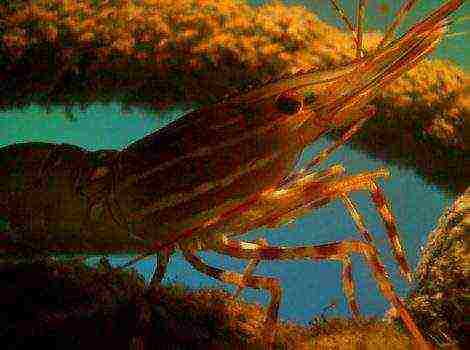Content

natural rhinestone crystals
CONTENT
- How to grow a crystal from salt
- How to grow a crystal from sugar
- How to grow a copper sulfate crystal
- How to grow a potassium alum crystal
Crystals of minerals are found everywhere in nature. Special conditions are needed for their education. For example, a rock granite comprises crystals of quartz, feldspar and mica, which crystallized one after another when the magma cooled.
Beautiful hexagonal crystals of rock crystal have grown from hot aqueous solutions saturated with silica SiO2.
natural sulfur crystals
Rhombic yellow crystals sulfur grew from hydrogen sulfide waters of hot springs and geysers.
On the shores of salt lakes and seas, one can see cubic crystals of rock salt - halite; white, red, yellow and even blue crystals of carnallite and mirabilite.
Diamonds, the hardest crystals, formed under tremendous pressure in the so-called explosion tubes (kimberlite tubes).
So, nature has created and continues to create crystals of minerals. Can we see the mystery of crystal growth? Can we grow them ourselves? Yes of course we can. And now I will tell you how to do it at home.
HOW TO GROW A SALT CRYSTAL
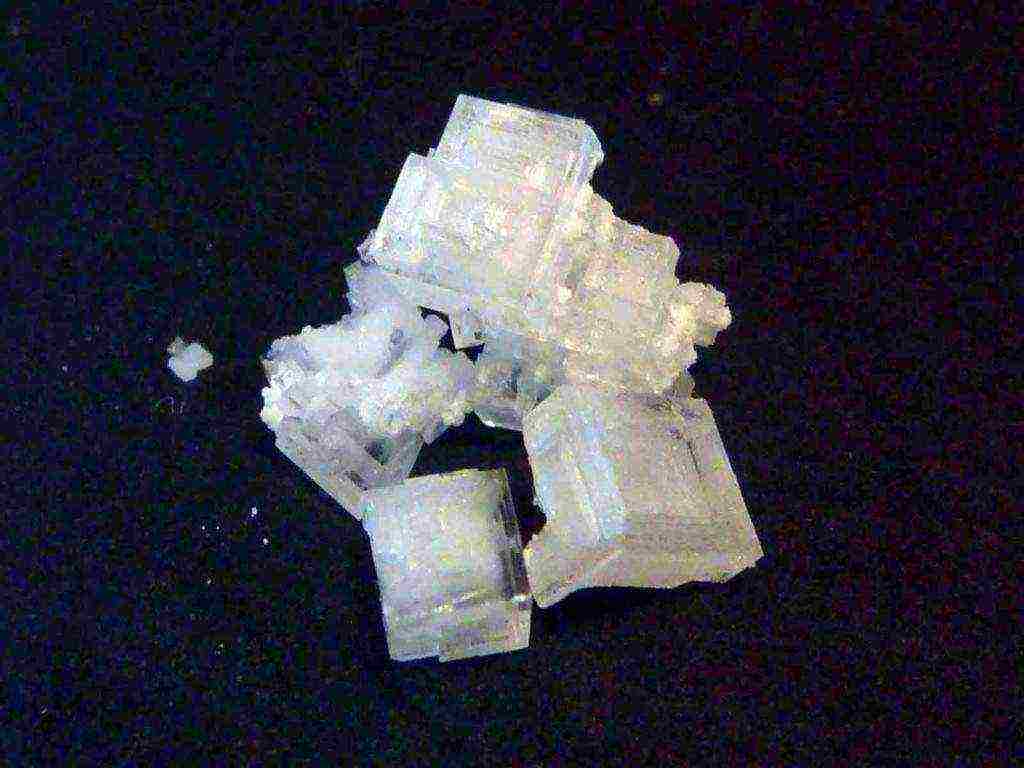
Grown Salt Crystals
In order to grow crystals of table (rock) salt (halite - NaCl), you need to put a container of water on the stove and bring the water to a boil. Then remove the container from the stove and dissolve the usual salt from the pack in it. Continuously stirring the solution, add salt until you notice that it no longer dissolves.
The resulting salty solution must be filtered and poured into a flat dish, for example, in a saucer. The water will cool down and begin to evaporate, and at the edges of the saucer and at its bottom you will see transparent cubes of the correct shape - these are crystals of rock salt, halite.
You can grow a large crystal, or several large cubic crystals. To do this, a woolen thread should be lowered into the container in which you dissolved the salt. When the solution cools, it will be covered with salt cubes. The slower the solution cools, the more regular crystals will have. After a while, growth will stop.
To grow one large crystal, you need to choose the most correct one from the many crystals formed at the bottom, put it on the bottom of a clean glass, and pour the solution from the previous dish on top.
Rest is necessary for the growth of the right crystals. Do not shake or move a table or shelf on which a container with growing crystals stands.
HOW TO GROW A SUGAR CRYSTAL
You can grow sugar crystals in the same way as salt crystals. Sugar crystals can also be grown on wooden sticks and can be a beautiful addition to any festive sweet dish. Food colors added to the solution will color the sugar in all the colors of the rainbow.
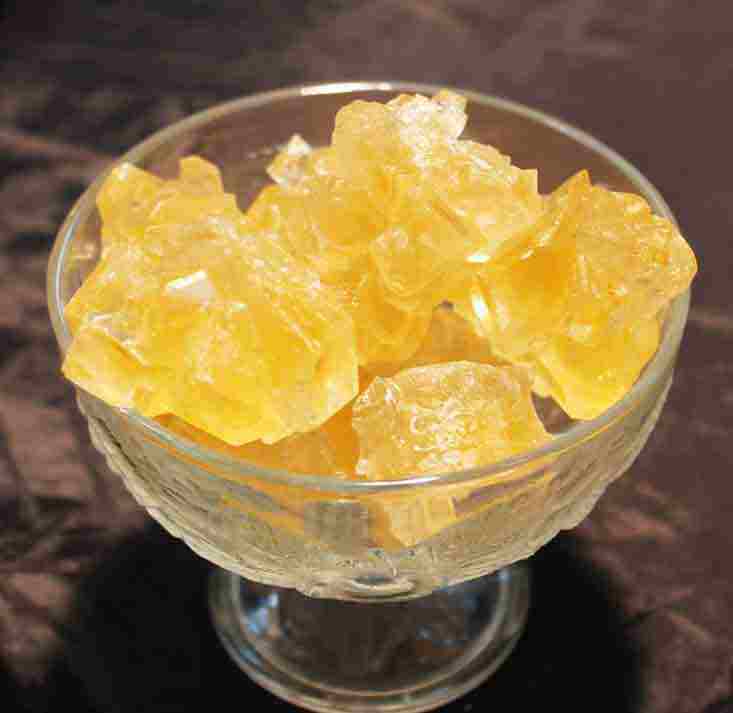
Sugar crystals
Below is the complete instruction, how to grow sugar crystals on sticks.
HOW TO GROW A CRYSTAL FROM COPPER CORE
Copper sulfate is sold in shops for gardeners, from it, and from slaked lime, they prepare "Bordeaux liquid" to protect plants from fungi and various diseases.
 To grow a crystal of copper sulfate (Cu SO4 * 5H2O) the correct form, you should dissolve powdered copper sulfate in water at a temperature of 80 degrees Celsius. At higher temperatures, the solubility of copper sulfate decreases. Dissolve the powder until dissolution stops. At the end of the wire or woolen thread we attach a seed - a small crystal of the same copper sulfate. Where can I get it? You can look for a larger crystal in the same bag from which you poured vitriol into the water. If this is not found, leave your solution to cool, and after a while you will see small crystals at the bottom.
To grow a crystal of copper sulfate (Cu SO4 * 5H2O) the correct form, you should dissolve powdered copper sulfate in water at a temperature of 80 degrees Celsius. At higher temperatures, the solubility of copper sulfate decreases. Dissolve the powder until dissolution stops. At the end of the wire or woolen thread we attach a seed - a small crystal of the same copper sulfate. Where can I get it? You can look for a larger crystal in the same bag from which you poured vitriol into the water. If this is not found, leave your solution to cool, and after a while you will see small crystals at the bottom.
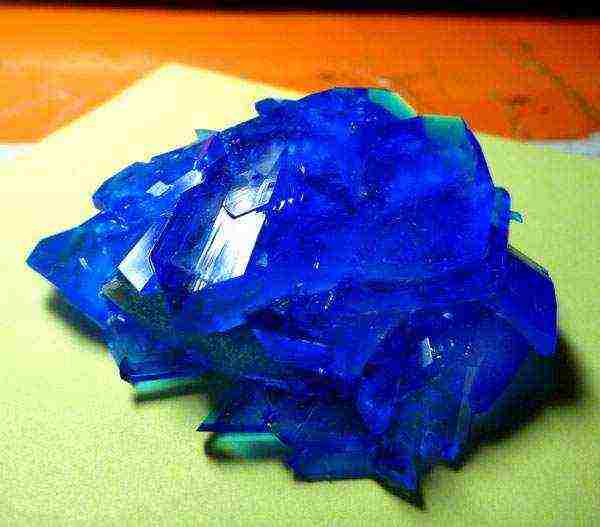 Pick one and tie (or glue) it to a wire or thread. Filter the solution. Then dip the prepared seed (crystal on thread) into it. Never immerse the seed in a hot solution! The seed can simply dissolve. A large crystal of copper sulfate grows for several weeks. The crystal, grown to the desired size, must be varnished, since the moisture contained in the air will eventually lead to its melting and destruction.
Pick one and tie (or glue) it to a wire or thread. Filter the solution. Then dip the prepared seed (crystal on thread) into it. Never immerse the seed in a hot solution! The seed can simply dissolve. A large crystal of copper sulfate grows for several weeks. The crystal, grown to the desired size, must be varnished, since the moisture contained in the air will eventually lead to its melting and destruction.
You can grow in an easy way beautiful copper crystals... A detailed description of the process can be found in the detailed article "How to Grow Copper Crystals".
Iron sulfate crystals are grown in a similar way, a detailed article about this can be read by following the link in this proposal.
HOW TO GROW A CRYSTAL FROM POTASSIUM ALUM

grown crystals of potassium alum
Potassium alum (KAI 2 * 12H2O - mineral alunite) are sold in the pharmacy in powder form. This is a good remedy that "dries the skin" and kills pathogens, this substance does not cause allergies and it is not toxic. Good crystals can be grown from potassium alum powder. Dissolve alum in warm water until saturation and filter the solution. After a few days in a calm place at room temperature, small crystals will appear at the bottom of the container.
potassium alum (burnt alum) can be bought at the pharmacy
From these crystals, you need to choose several pieces of the correct shape and place them in another container. Then they are poured with the same solution. You can hang the seeds on thin threads (they can be glued to the thread with durable waterproof glue). Once every two to three days, the crystals must be transferred to a new glass, and the solution must be filtered and the growing crystals must be poured over again. Alum crystals grown to the required size should be varnished so that they do not melt from moisture in the air and do not lose their shape.
It is desirable to prepare solutions for growing crystals with distilled water.
At home, you can get an artificial malachiteusing copper sulfate and washing soda, but it will not be beautiful crystals or an openwork patterned stone, but a green or dirty green sediment at the bottom of the vessel (powder). Beautiful malachite, which practically does not differ from natural, can be obtained only on industrial equipment.
The factories also grow crystals of many minerals. But at home it is impossible to repeat this, for this you need special equipment. Most crystals (quartz, amethyst, ruby, emerald, diamonds, malachite, garnets, etc.) are grown in cast iron autoclaves under high pressure. Temperatures reach 500-1000 degrees, and pressure - 3000 atmospheres.
Crystal Growing Kits
crystal growing kit
Now in toy stores, in large cities, kits for growing crystals have appeared on sale. From powders dihydrogen phosphate of ammonium and potassium, to which dyes are added, interesting prismatic and needle crystals can be grown. In order for the crystals to be large and beautiful enough, you must strictly follow the attached instructions.
Strange, but the instructions in the box shown in the photo do not indicate which chemical is used to grow the crystals and which dye is used. Otherwise, it is quite detailed.
Growing ruby crystals at home is available to everyone.The work does not require an equipped laboratory, obtaining theoretical and practical knowledge in the field of mineralogy, or purchasing special chemical reagents. Everything you need can be found in the kitchen.
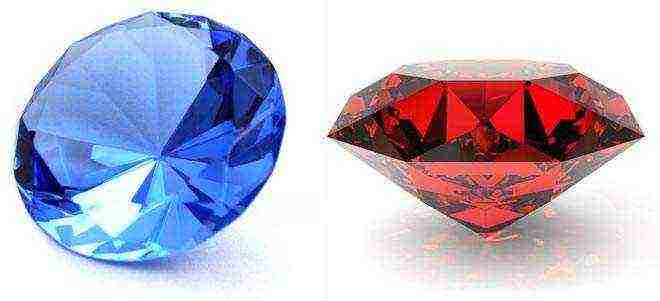
Home experimentation
It is advised to start growing rubies with small volumes. First, experience is gained, the whole process is understood, and then direct systematic work begins. Synthetic creation of your own hands will not be inferior in beauty and attractiveness to natural minerals. Gemstones are in demand among jewelers, so a successful experience can bring additional income if you find a sales market.
There are several ways to grow. They advise you to try all the options, then stop at the one you like.
Artificial precious rocks, created by man, do not differ from natural ones in chemical content and physical properties. The advantage of home technology is that it allows you to create perfectly clean breeds. In nature, this happens extremely rarely. The gem quality of laboratory samples is quite good. Another plus of the mineral is its cost. The stones are cheaper than their originals, which originate in deep mines.
Organic salts
It is easy to grow a ruby crystal from various salts:
- copper sulfate;
- potassium alum;
- ordinary salt.
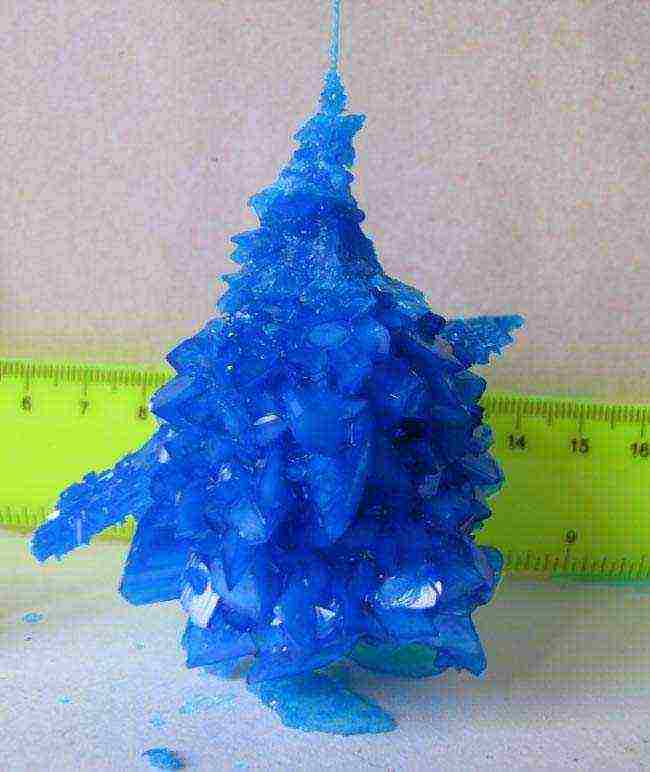
The longest salt-based process, the most beautiful specimens are obtained from vitriol. The production of ruby crystals is based on the following stages:
- Preparing the container. It should hold salt and a saturated saline solution. Take hot water. The process is gradual. Dilute two tablespoons with water, mix thoroughly. Then add salt and mix. you need to sprinkle until the salt stops dissolving. To comply with the proportions, they take a hint: a table of the solubility of different salts in 100 ml of water, their relationship with the temperature of the liquid.
- Filtration of the solution. The solution must be clean. Dirt impurities will spoil the structure of the stone. Defects will be visible in it. The solution remains for 24 hours. During this period, crystals form at the bottom of the tank. They will form the basis of the ruby.
- Artificial mineral growth. A fishing line is tied to the stone formed at the bottom of the glass. It is wrapped around a pencil or wooden stick. The device is installed on the container. The crystal is suspended in solution. Water tends to evaporate, saturated salt solution releases excess, which is fixed on the resulting sample.
- Adding salt solution. Water always needs a certain amount, if it becomes too little, the crystal will stop growing. At normal room temperature, water is added every 2 weeks.
To get rubies at home, you will have to wait about 3 months. Then the stone is freed from the saline solution, dried with a soft napkin. The sample is covered with colorless nail polish in several layers.
Advice from experienced crystal makers. The salt solution must be at the same temperature as the water in the container. The crystal grows even at a slightly lower temperature, but high rises in solutions spoil and stop growth.
Apparatus for work at home
To create rubies at home, you need an apparatus named after its creator, Verneuil. The inventor's technique allows to grow a ruby weighing 30 carats in 3 hours. The technology has made it possible to create the precious material in the right quantity. Industrial facilities began to actively implement the development of Verneuil. Time has made its own adjustments, and today such a device is easily assembled at home. Components of the device:
- cathetometer;
- shaking mechanism;
- bunker;
- burner;
- muffle;
- growing crystal;
- crystal holder;
- crystal lowering mechanism.
The device is used for growing not only rubies. Often, blue topaz, emeralds and stones with a translucent transparent structure are created in the device.
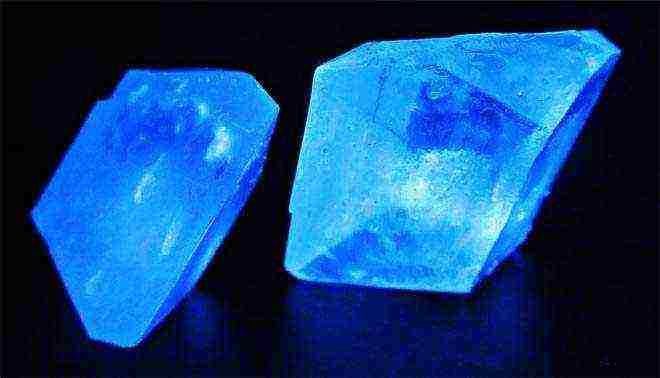
Home production process:
- Powder is poured into the hopper through a funnel. The composition of the powder is Al2O3, the additional component is Cr2O3.
- The burner supplies the flame to the bottom of the hopper.
- The powder starts to melt.
- The layers of molten powder are a growing ruby crystal.
Through the lowering mechanism, the artificial mineral moves downward. Various shades can be obtained in the device. The rate of crystal formation is higher than in the container. It only takes 3 hours to admire the ruby. One sample requires the following component volumes:
- 6 g Al2O3;
- 0.2 g Cr2O.
Untreated crystalline formations are extraordinary in shape. They are originally similar to natural ones, but at the same time they are always unique.
At first glance, working with the device is difficult and painstaking. In fact, a device invented by a French inventor over 100 years ago will not pose any particular problems. It is assembled from parts that practical people have on the farm. Making an apparatus and purchasing powder are the main stages of preparation.
2>Economic calculations
Home technology is always cheaper. You can calculate the cost of all components, costs, and determine the approximate cost of the resulting samples. What is ruby taken into account:
- the cost of parts of the device;
- electricity costs;
- the price for the purchase of powders for the base of the crystal.
Even approximate calculations will show the benefits. The cost of all the components will not be even 500 rubles. For that kind of money, it is difficult to buy a ruby jewelry of a beautiful appearance and excellent quality. The process should not intimidate domestic experimenters with legitimacy. Natural minerals are regulated by the state, synthetic ones are not subject to documents. If a decision is made to open a small production, it should be registered in accordance with the established procedure. The soul will be in place, the work will only bring satisfaction.
> A gem that you create yourself will become a pride. The craftsman will gradually learn to change the shades of rubies. The next step will be to creatively work on the resulting samples, transforming them into interior design items and original decorations.
Introduction
1. Theory of crystals.
Crystals are solids, whose atoms or molecules occupy definite, ordered positions in space. Therefore, the crystals have flat faces. For example, a grain of ordinary table salt has flat edges that make up right angles to each other. Metals have a crystalline structure. If we take a relatively large piece of metal, then at first glance its crystalline structure does not manifest itself in any way in the appearance of the piece or in its physical properties. Metals in their normal state do not exhibit anisotropy. The point here is that usually the metal consists of a huge number of small crystals grown together with each other. The properties of each crystal depend on the direction, but the crystals are randomly oriented in relation to each other. As a result, in a volume significantly exceeding the volume of individual crystals, all directions within the metals are equal and the properties of metals are the same in all directions. A solid, consisting of a large number of single crystals, is called polycrystalline... Single crystals are called single crystals... Polycrystals are not limited to metals. Most crystalline bodies are polycrystals, as they consist of many intergrown crystals. Single crystals - single crystals have the correct geometric shape, and their properties are different in different directions.
Liquid crystals - substances that behave simultaneously as liquids and as solids. Molecules in liquid crystals, on the one hand, are quite mobile, on the other hand, they are arranged regularly, forming a semblance of a crystal structure (one-dimensional or two-dimensional). Often, even with a slight heating, the correct arrangement of the molecules is disturbed, and the liquid crystal becomes an ordinary liquid.On the contrary, at sufficiently low temperatures, liquid crystals freeze, turning into solids. The regular arrangement of molecules in liquid crystals determines their special optical properties. The properties of liquid crystals can be manipulated by exposing them to a magnetic or electric field. It is used in LCD displays for watches, calculators, computers and the latest TVs. Taking great precautions, it is possible to grow a large crystal - a single crystal.
Under normal conditions, a polycrystalline body is formed as a result of the beginning of the growth of many crystals continues until they come into contact with each other, forming a single body - a polycrystal (Fig. 1).
Figure 1. Polycrystalline copper
To grow a crystal, it is helpful to know what processes govern its growth; why different substances give crystals of different shapes, and some do not form crystals at all; what needs to be done to make the crystals big and beautiful.
If crystallization proceeds very slowly, then one large crystal is obtained, if quickly - many small crystals. Crystals are grown in different ways:
1. Cooling of a saturated solution.
With decreasing temperature, the solubility of most substances decreases and they are said to precipitate. First, tiny nucleated crystals appear in the solution and on the walls of the vessel. When the cooling is slow, and there are no solid impurities (say, dust) in the solution, few nuclei are formed, and gradually they turn into beautiful crystals of regular shape. With rapid cooling, many crystallization centers appear, the process itself is more active, and the correct crystals will not work out (see Fig. 2)
Figure 2. Many different small crystals formed on the walls of the vessel
2. Gradual removal of water from a saturated solution
In this case, the slower the water is removed, the better the crystals are obtained. You can leave an open container with a solution at room temperature for a long time - the water will evaporate slowly (especially if you put a sheet of paper on top or cover it with gauze). The growing crystal can either be suspended in a saturated solution on a thin strong thread, or placed on the bottom of a vessel. In the latter case, the crystal must be periodically turned to the other side. As the water evaporates, add fresh solution to the vessel (see Fig. 3).
Figure 3. Crystal obtained at the bottom of the vessel from a solution of copper sulfate with the addition of salt and iron filings
3. Rapid removal of water from a saturated solution
In this case, crystals are obtained with a regular shape, with sharp edges, but small (the solution was in a wide vessel next to the heater) (see Fig. 4)
Figure 4. Single crystals obtained by rapid evaporation of the solution
Growing crystals is an interesting, entertaining process, but it requires a careful and careful attitude to your work. From time to time, the crystallizer must be cleaned: drain the solution and remove small crystals that have grown on the main one, as well as on the walls and bottom of the vessel. In theory, the size of a crystal that can be grown in this way is unlimited. If the grown crystal is left open in dry air, it gradually loses the water it contains and turns into a nondescript gray powder. To protect the crystal from destruction, it can be coated with a colorless varnish.
Crystal growing methods
In research laboratories and industry, crystals are grown from vapors, melts and solutions, from the solid phase, synthesized by chemical reactions, electrolytic crystallization, crystallization from gels and others are carried out. Currently, the following growing methods are most often used to obtain perfect large-diameter crystals:
- from the gas (vapor) phase at a pressure gradient,
- from melts at a temperature gradient,
- from solutions with a concentration gradient at the crystal-solution interface.
Crystallization from the vapor (gas) phase is widely used for growing both bulk crystals and epitaxial films, thin (polycrystalline or amorphous) coatings, whiskers and lamellar crystals. The specific growing method is chosen depending on the material. In growing methods based on the physical condensation of the crystallized substance, the substance enters the growing crystal in the form of its own vapor, consisting of molecules of their associations - dimers, trimmers, and so on. In the method of synthesis in the vapor phase, the crystallizable compound is formed as a result of the reaction between the gaseous components directly in the crystallization zone.
Melt crystallization is the most common method for growing single crystals. Currently, more than half of the technically important crystals are grown from melt. Substances most suitable for melt growth are those that melt without decomposition, have no polymorphic transitions, and have low reactivity. Elementary semiconductors and metals, oxides, halides, chalcogenides, tungstates, vanadates, niobates, and other substances are grown by crystallization from a melt. In some cases, single crystals are grown from the melt, which include five or more components. During crystallization from a melt, it is important to take into account the processes affecting the composition of the melt (thermal dissociation, evaporation, interaction of the melt with the environment), processes at the crystallization front, heat transfer processes in the crystal and melt, mass transfer processes (transfer of impurities due to convection and diffusion in the melt) ...
Crystallization from solutions is used for growing substances that decompose at temperatures below the melting point. The growth of crystals is carried out at temperatures below the melting point; therefore, crystals grown by such methods do not contain defects characteristic of crystals grown from a melt. When crystals are grown from solutions, the driving force of the process is supersaturation. By the method of temperature difference, for example, crystals of potassium dihydrogen phosphate and ammonium dihydrogen phosphate are grown. The growth rate of crystals under such conditions is about 1 mm / day. Crystals weighing 400 g grow within 1.5-2 months.
Crystals and their applications.
Living on an Earth composed of crystalline rocks, we certainly cannot get away from the problem of crystallinity: we walk on crystals, build from crystals, process crystals in factories, grow them in laboratories, widely use them in technology and science, eat crystals, heal them ... The science of crystallography deals with the study of the variety of crystals. She comprehensively examines crystalline substances, examines their properties and structure. In ancient times, crystals were believed to be rare. Indeed, the presence of large homogeneous crystals in nature is an infrequent phenomenon. However, fine-crystalline substances are very common. So, for example, almost all rocks: granite, sandstones, limestone are crystalline. As research methods improved, substances that had previously been considered amorphous turned out to be crystalline. Now we know that even some parts of the body are crystalline, for example, the cornea of the eye, vitamins, the myelin sheath of nerves are crystals. The long path of searches and discoveries, from measuring the external shape of crystals in depth, to the subtleties of their atomic structure, is not yet complete. But now researchers have studied its structure quite well and are learning to manipulate the properties of crystals.
Crystals are beautiful, one might say, some kind of miracle, they attract to themselves, they are an intermediate link between living and inanimate matter.Crystals can be born, aged, destroyed. A crystal, when it grows on a seed (on an embryo), inherits the defects of this very embryo.
The crystal is miraculous in its properties; it performs a variety of functions. These properties are inherent in its structure, which has a lattice three-dimensional structure. As an example of the use of crystals, you can take the quartz crystal, which is used in telephone handsets. If a quartz plate is mechanically influenced, then an electric charge will arise in it in the corresponding direction. In the microphone tube, quartz converts mechanical vibrations in the air caused by the speaker into electrical vibrations. Electrical vibrations in the subscriber's tube are converted into vibrational ones, and, accordingly, he hears speech. Being lattice, the crystal is faceted and each facet, as a person, is unique. If a face is densely packed in a lattice with material particles (atoms or molecules), then this is a very slowly growing face. For example, a diamond. Its faces have the shape of an octahedron, they are very densely packed with carbon atoms, and due to this, they differ in brilliance and strength.
Practical part
Job title: Growing crystals of table salt, copper sulfate and sugar at home
Target: Grow crystals from saturated solutions of salt, copper sulfate, sugar and make sure by experience that the crystals of these substances have the correct shape.
Relevance of the chosen topic.
The world around us consists of crystals, we can say that we live in the world of crystals. Residential buildings and industrial structures, airplanes and rockets, motor ships and diesel locomotives, rocks and minerals are composed of crystals. We eat crystals, heal with them and are partially made of crystals.
Crystals are substances in which the smallest particles are “packed” in a specific order. As a result, during the growth of crystals, flat faces spontaneously appear on their surface, and the crystals themselves take on a variety of geometric shapes. The origin of the word "crystal" is interesting. Many centuries ago, in the snows of the Alps on the territory of modern Switzerland, very beautiful colorless crystals were found, resembling pure ice. The ancient naturalists called them so - "crystallos", in Greek ice. It was believed that the ice, being in the mountains for a long time, in severe frost, turns to stone and loses its ability to melt. Aristotle wrote that "crystallos is born from water when it completely loses its warmth." Back in the Middle Ages, this term "crystal" was applied exclusively to quartz. At the same time, most of the natural minerals have a crystalline structure. The first mineralogists were primarily interested in the form of crystals, the variety of which is striking. The famous Russian crystallographer E.S. Fedorov, who theoretically derived the laws of crystal construction, said: "Crystals shine with symmetry." Crystals are really so pretty that you can admire them for hours. Many scientists who have made a great contribution to the development of chemistry and mineralogy began their first experiments with growing crystals, trying to understand how they are formed.
And I decided to start my research work with a goal: to get crystals of various substances at home.
Purpose of the study: study of the dependence of the shape and size of crystals on temperature
Research objectives:
1. Grow a single crystal.
2. Grow polycrystal.
Object of study:
1.solution of copper sulfate
2.solution of table salt
3.sugar solution
Subject of study: crystals of salt and sugar
Experiment # 1: Growing Salt Crystals
This process does not require any special chemicals. Crystals of sodium chloride NaCl are colorless transparent cubes.
I poured edible salt into a glass of water at a temperature of 20 ° C and left for a few minutes, stirring beforehand. During this time, the salt has dissolved. Then he added more salt and mixed again.I repeated this step until the salt dissolves and settles to the bottom of the glass. This is how I got a saturated salt solution. I poured it into a clean glass of the same volume, while getting rid of the excess salt at the bottom. I took one larger crystal of table salt and placed it in the bottom of the glass with a saturated solution. Already after 3 days, a significant growth for the crystal was noticeable. It increased every day. Then I did the same thing again (I prepared a saturated salt solution and dipped this crystal into it), it began to grow much faster - from 0.3 to 0.9 cm in size over the next 3 days (see Fig. 5)
Figure 5. Colorless transparent sodium chloride cubes
Experiment No. 2. Growing copper sulfate crystals
I prepared a solution of copper sulfate as follows: I poured water into a glass (200 g) and put it in a saucepan with warm water at 50 ° C and began to dissolve 100 g of copper sulfate powder. Also, like a solution of sodium chloride, left for several days. First, by rapid evaporation in an open vessel on the walls, I obtained single crystal copper sulfate (see fig. 6)
Figure 6. Single crystal, nucleus for polycrystal
Then I placed it in a new solution for further growth at room temperature and in a closed vessel. After 2 weeks, a polycrystal with a size of 2.8 cm was obtained (see Fig. 7).
Figure 7. Polycrystal 2.8 cm
Experiment # 3. Growing sugar crystals
In order to grow a crystal from sugar, you need to boil water and pour boiling water into a glass. Then start pouring sugar into the water and stir constantly. Continue to do this until the sugar stops dissolving, i.e. until the solution becomes supersaturated.
Take a thin thread that is not too long. Tie one end of the string to the pencil directly in the center, and tie a small crystal of sugar to the other end (fig. 8).
Figure 8. Pencil seed
Place the pencil on a glass of sugar solution and lower the thread. Then you just have to wait. At best, a small sugar crystal can grow in 2-3 days, and at worst, you will have to wait for a noticeable result for one and a half to two months (Fig. 9).
Figure 9. Grown sugar crystal
Conclusion
The process of growing crystals at home is a very interesting and exciting activity that allows you to consciously relate to the laws of nature. The work on growing crystals made me more observant, broadened my horizons, introduced me to science, allowed me to be surprised. Experiencing the "miracle" of cultivation brought me a lot of positive emotions and vivid impressions. Research work opened the door for me to the mysterious land of crystals and minerals.
The crystals I received can be used in chemistry and physics lessons as a demonstration material.
Literary sources:
1. Encyclopedic Dictionary
2. MEGAENCYCLOPEDIA OF KIRILL AND METHODIA /> 3. Zorky PM Symmetry of molecules and crystal structures. Moscow: Moscow State University Publishing House, 1986 .-- 232 p.
4. Likhachev VA, Malinin VG Structural-analytical theory of strength. - SPb: Science. - 471 p.
5. Shaskolskaya M. P. Crystals. Moscow: Nauka, 1985.208 p.
6. Materials of the Internet.
I've done the work: Smolennikov Pavel Sergeevich
student of 11 "B" grade
Supervisor: Krestyannikova Elena Valerievna
chemistry teacher, 1st category
MSI "Secondary school No. 12 of the village of Osakarovka"
akimat of Osakarovsky district
Karaganda region
The Republic of Kazakhstan
Growing crystals - what you need to know!
Growing crystals - the process is very interesting, but it can be quite lengthy. It is useful to know what processes are driving its growth; why different substances form crystals of different shapes, and some do not form them at all; what needs to be done to make them big and beautiful.
If crystallization proceeds very slowly, one large crystal is obtained (or a single crystal, for example, when growing artificial stones), if quickly, then a lot of small ones (or a polycrystal, for example, metals).
Growing crystals at home produced in different ways. For example, by cooling a saturated solution. With decreasing temperature solubility of substances decreases (mostly anhydrous salt) and they are said to precipitate. First, tiny nucleated crystals appear in the solution and on the walls of the vessel. When the cooling is slow, and there are no solid impurities (say, dust) in the solution, few nuclei are formed, and gradually they turn into beautiful crystals of regular shape. With rapid cooling, many small crystals appear, almost none of them has the correct shape, because many of them grow and they interfere with each other.
Sugar crystal
Growing crystals can be done in another way - the gradual removal of water from a saturated solution. And in this case, the slower the water is removed, the better the result will be. Leave the vessel with the solution open at room temperature for a long time, covering it with a sheet of paper - the water will evaporate slowly, and dust will not get into the solution. The growing crystal can either be suspended in a saturated solution on a thin strong thread, or placed on the bottom of a vessel. In the latter case, the crystal must be periodically turned to the other side. As the water evaporates, a fresh solution should be poured into the vessel. Even if our original crystal had an irregular shape, sooner or later it will straighten out all its defects by itself and take the form inherent in this substance, for example, it will turn into an octahedron if you use a salt of chromium potassium alum, a rhombus if you use copper sulfate.
Crystals
potassium aluminum alum
Growing crystals - an entertaining process, but it requires a careful and careful attitude to your work. In theory, the size of a crystal that can be grown at home in this way is unlimited. There are cases when enthusiasts received crystals of such a size that they could only be lifted with the help of comrades.
But, there are some peculiarities of their storage (of course, each salt and substance has its own characteristics). For example, if a crystal of alum is left open in dry air, it gradually loses the water it contains and turns into a nondescript gray powder. To protect it from destruction, you can cover it with a colorless varnish. Copper sulfate and table salt are more resistant and you can safely work with them.
How to grow a crystal
Potassium iodide crystal
(KI)
Grow a crystal can be made from different substances: for example, from sugar, even stone - artificial cultivation of stones, in compliance with strict rules for temperature, pressure, humidity and other factors (artificial rubies, amethysts, quartz, citrines, morions).
At home, of course, we will not be able to do all this, so we will act in a different way. We will grow salt crystals... We all have ordinary table salt at home (as you probably know that its chemical name is sodium chloride NaCl). Any other salt is also suitable (salt - from a chemical point of view), for example, you can get beautiful blue crystals from copper sulfate or any other sulfate (for example, iron). You can use alum (double metal salts of sulfuric acid), sodium thiosulfate (previously used for making photographs). For all these salts (and indeed for salt), no special conditions are required: they made a solution, put the "embryo" there (all this is described in detail below) and it grows for itself, adding in growth every day.
Yes, you should not paint the solution where your crystal grows, for example, with paints or something similar - this will only spoil the solution itself, but the crystal will still not paint! The best way to get colored crystals is to match the color of your salt! But be careful: for example, crystals of yellow blood salt have a red-orange color - and the solution turns out to be yellow.
Now we can get started!
Growing table salt crystals
Table salt crystals
(NaCl)
Table salt crystals - the growing process does not require any special chemicals. We all have table salt (or table salt) that we eat. It can also be called stone - everything is the same. Crystals of sodium chloride NaCl are colorless transparent cubes. Let's start. Dilute the sodium chloride solution as follows: pour water into a container (for example a glass) and put it in a saucepan with warm water (no more than 50 ° C - 60 ° C). Of course, ideally, if the water does not contain dissolved salts (i.e. distilled), but in our case, you can use tap water. Pour edible salt into a glass and leave for 5 minutes, stirring first. During this time, the glass of water will heat up and the salt will dissolve. It is advisable that the water temperature does not drop yet. Then add more salt and stir again. Repeat this step until the salt dissolves and settles to the bottom of the glass. We got a saturated salt solution. Pour it into a clean container of the same volume, while getting rid of excess salt at the bottom. Choose any larger crystal of table salt you like and place it on the bottom of a glass with a saturated solution. You can tie the crystal by a string and hang it so that it does not touch the walls of the glass. Now you have to wait. Within a couple of days, you can notice a significant growth for the crystal. It will increase every day. And if you do the same thing again (prepare a saturated salt solution and dip this crystal into it), then it will grow much faster (remove the crystal and use the already prepared solution, adding water and the necessary portion of edible salt to it). Remember that the solution must be saturated, that is, when preparing the solution, salt should always remain at the bottom of the glass (just in case). For information: about 35 g of table salt can dissolve in 100 g of water at a temperature of 20 ° C. As the temperature rises, the solubility of the salt increases.
This is how the crystals of table salt are grown (or crystals of salt, the shape and color of which you prefer)
Growing copper sulfate crystals
Copper sulfate crystals - are grown in the same way, as with table salt: first, a saturated salt solution is prepared, then a small crystal of copper sulfate salt is dropped into this solution.
Attention! copper sulfate - - chemically active salt! Therefore, for the success of the experiment in this case, you need to take distilled water, i.e. not containing other salts dissolved in it. It is also better not to take water from the tap, since it firstly contains dissolved salts, and secondly, it can be highly chlorinated. Impurities (especially carbonates in a hard one) enter into chemical reactions with copper sulfate, due to which the solution deteriorates greatly If everything is in order, we will continue. If you decide not to pour the solution from the container in which the small crystal originally grew, then hang the crystal so that it does not touch other crystals remaining at the bottom!
Crystals are grown not only from solutions, but also from salt melts. A striking example is the yellow opaque crystals of sulfur, in the form of a diamond or elongated prisms. But I do not advise you to work with sulfur especially. The gas generated by its evaporation is harmful to health.
The growth of individual crystal faces can be avoided. To do this, these edges must be applied with a solution of petroleum jelly or fat.
Growing copper crystals
:
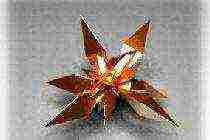 Copper crystals (Cu)
Copper crystals (Cu)
Now let's grow red copper crystals... We need copper sulphate, table salt, a steel plate in the shape of the container section (a little smaller perimeter. You can use steel shavings or buttons), where copper crystals and a circle of blotting paper in the shape of a section will grow. So, put some copper sulfate on the bottom of the bubble (preferably evenly over the area). Sprinkle table salt on top and cover it all with a cut out circle of paper. Put an iron plate on it (or cover it with steel shavings). All this together must be poured with a saturated solution of table salt (we prepared such a solution from table salt). Leave the container for about a week. During this time, acicular red crystals of copper will grow. When the growth process is in progress, try not to carry the container, and it is also very undesirable to remove the crystals from the solution.
You can grow a multi-colored and multi-layered crystal. They are obtained by preparing solutions of alum (double salts of sulfuric acid) and transferring alternately grown crystals from one solution to another.
If you mix hot concentrated solutions of aluminum sulfates Al2 (SO4) 3 and potassium K2 (SO4), and the resulting solution is cooled, then alum will begin to crystallize from it - double sulfate of potassium and aluminum 2KAl (SO4) 2 • 12H2O. Alum dissolves in water as follows: 5.9 g per 100 g of water at 20 ° C, but already 109 g at 90 ° C in terms of anhydrous salt. When stored in air, alum is weathered. At a temperature of 92.5 ° C, they melt in their crystallization water, and when heated to 120 ° C, they dehydrate, turning into burnt alum, which decomposes only at temperatures above 700 ° C. The water molecules that make up the alum are chemically bonded with potassium and aluminum ions, so alum salts have a formula that is more correctly written in the form of a complex salt (SO4) 2.
Something about liquid crystals
Liquid crystals Are substances that behave like liquids and solids at the same time. Molecules in liquid crystals, on the one hand, are quite mobile, on the other hand, they are arranged regularly, forming a semblance of a crystal structure (one-dimensional or two-dimensional). Often, even with a slight heating, the correct arrangement of the molecules is disturbed, and the liquid crystal becomes an ordinary liquid. On the contrary, at sufficiently low temperatures, they freeze, turning into solids. The regular arrangement of molecules in liquid crystals determines their special optical properties. Their properties can be controlled by subjecting them to a magnetic or electric field. It is used in LCD displays for watches, calculators, computers and the latest TVs.
So the process growing crystals at home divided into main steps:
Stage 1: Dissolve the salt from which the crystal will grow in heated water (it needs to be heated so that the salt dissolves a little more than it can dissolve at room temperature). Dissolve the salt until you are sure that the salt no longer dissolves (the solution is saturated!). I recommend using distilled water (i.e., free from impurities of other salts)
Stage 2: Pour the saturated solution into another container, where crystals can be grown (taking into account that it will increase). At this stage, make sure that the solution does not cool too much.
Stage 3: Tie a crystal of salt on a string, tie the string, for example, to a match and put the match on the edges of the glass (container) where the saturated solution is poured (stage 3). Dip the crystal in a saturated solution.
Step 4: Transfer the container with the saturated solution and crystal to a place free of drafts, vibration and strong light (growing crystals requires compliance with these conditions).
Step 5: Cover the top of the container with a crystal (for example, paper) with something from dust and debris. Leave the solution on for a couple of days.
Important to remember!
1.The crystal cannot be removed from the solution during growth without a special reason
2.Do not allow debris to enter the saturated solution, it is most preferable to use distilled water
3. monitor the level of the saturated solution, periodically (once a week or two) renew the solution when evaporating
Salt water solubility plots
Growing crystals. WHAT YOU NEED TO KNOW!


